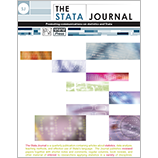Maximum likelihood estimation of endogenous switching and sample selection models for binary, ordinal, and count variables
Alfonso Miranda
School of Economic and Management Studies
Keele University
Keele, UK
[email protected]
|
Sophia Rabe-Hesketh
Graduate School of Education
University of California
Berkeley, CA, and
Institute of Education
University of London
London, UK
|
Abstract. Studying behavior in economics, sociology, and statistics often involves
fitting models in which the response variable depends on a dummy
variable—also known as a regime-switch variable—or in which the
response variable is observed only if a particular selection condition is
met. In either case, standard regression techniques deliver inconsistent
estimators if unobserved factors that affect the response are correlated
with unobserved factors that affect the switching or selection variable.
Consistent estimators can be obtained by maximum likelihood estimation of a
joint model of the outcome and switching or selection variable. This article
describes a “wrapper” program, ssm, that calls
gllamm (Rabe-Hesketh, Skrondal, and Pickles, GLLAMM Manual
[University of California–Berkeley, Division of Biostatistics, Working
Paper Series, Paper No. 160]) to fit such models. The wrapper accepts data
in a simple structure, has a straightforward syntax, and reports output that
is easily interpretable. One important feature of ssm is that the log
likelihood can be evaluated using adaptive quadrature (Rabe-Hesketh,
Skrondal, and Pickles, Stata Journal 2: 1–21; Journal of
Econometrics 128: 301–323).
View all articles by these authors:
Alfonso Miranda, Sophia Rabe-Hesketh
View all articles with these keywords:
endogenous switching, sample selection, binary variable, count data, ordinal variable, probit, Poisson regression, adaptive quadrature, gllamm, wrapper, ssm
Download citation: BibTeX RIS
Download citation and abstract: BibTeX RIS
|
